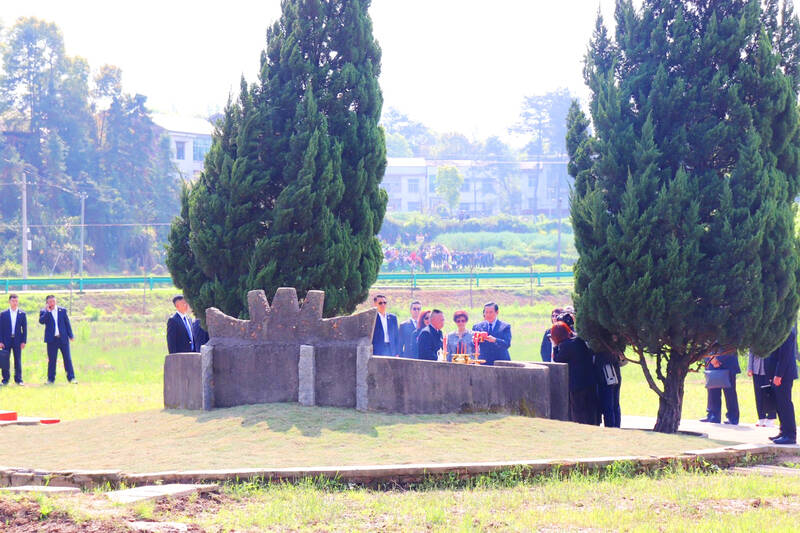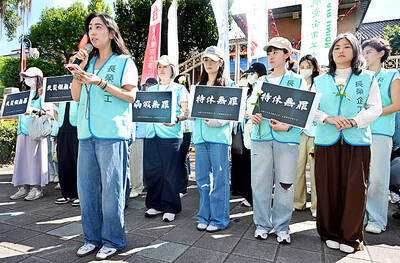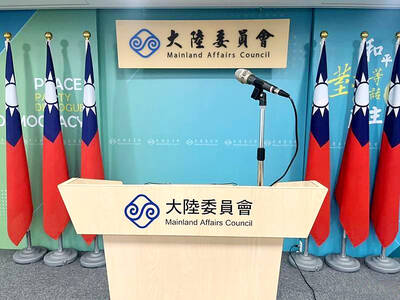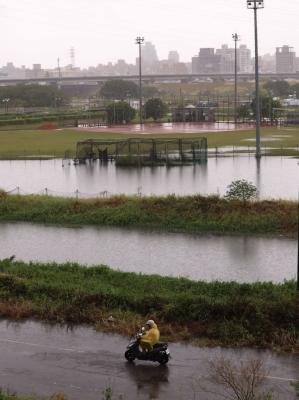Former president Ma Ying-jeou (馬英九) yesterday referred to Taiwan by its official name, the Republic of China (ROC), during an ancestor worship ritual in China.
Speaking at the burial site of his ancestors in Xiangtan, Hunan Province, Ma said he was elected twice as “president of the ROC,” in the years 92 and 101 on the ROC calendar, referring to 2008 and 2012.
As president, Ma said, he governed with integrity, diligence and care for the people, as he was guided by his family’s philosophy that the main purpose of education is to do good deeds for others.

Photo: CNA
His presidency was the most peaceful and prosperous period in the 70 years of separate governance in Taiwan and China, he said.
His administration achieved it through a policy of maintaining peace with China, building closer ties with the US and enhancing friendship with Japan, Ma said, as he, his sisters and other family members burned incense and made offerings at their ancestors’ grave site.
“This is the first time in my life that I’ve come to the mainland to worship my ancestors and visit my relatives,” Ma said. “It is very emotional.”
The former president’s parents, Ma Ho-ling (馬鶴凌) and Chin Hou-hsiu (秦厚修), moved to Taiwan via Hong Kong after the Chinese Civil War of 1945-1949.
His historic 12-day trip to China, which started on Monday, marks the first of a former Taiwanese president since the ROC government retreated to Taiwan.
During his trip, Ma has used the term ROC on several occasions, but all instances have been edited out of China Central Television coverage of his visit.
At an event in Nanjing on Tuesday, Ma dated a calligraphy scroll “112,” referring to the 112th year since the founding of the ROC.
However, Ma did not write the characters for minguo (republican, 民國) in front of the date to refer to the ROC calendar, as is common in Taiwan.
However, he used the term several times in remarks.
Ma’s trip, and his choice of words, have been criticized by the Democratic Progressive Party (DPP) and pro-independence groups in Taiwan.

The Taoyuan Flight Attendants’ Union yesterday vowed to protest at the EVA Air Marathon on Sunday next week should EVA Airway Corp’s management continue to ignore the union’s petition to change rules on employees’ leave of absence system, after a flight attendant reportedly died after working on a long-haul flight while ill. The case has generated public discussion over whether taking personal or sick leave should affect a worker’s performance review. Several union members yesterday protested at the Legislative Yuan, holding white flowers and placards, while shouting: “Life is priceless; requesting leave is not a crime.” “The union is scheduled to meet with

‘UNITED FRONT’ RHETORIC: China’s TAO also plans to hold weekly, instead of biweekly, news conferences because it wants to control the cross-strait discourse, an expert said China’s plan to expand its single-entry visa-on-arrival service to Taiwanese would be of limited interest to Taiwanese and is a feeble attempt by Chinese administrators to demonstrate that they are doing something, the Mainland Affairs Council said yesterday. China’s Taiwan Affairs Office (TAO) spokesman Chen Binhua (陳斌華) said the program aims to facilitate travel to China for Taiwanese compatriots, regardless of whether they are arriving via direct flights or are entering mainland China through Hong Kong, Macau or other countries, and they would be able to apply for a single-entry visa-on-arrival at all eligible entry points in China. The policy aims

Taipei, New Taipei City, Keelung and Taoyuan would issue a decision at 8pm on whether to cancel work and school tomorrow due to forecasted heavy rain, Keelung Mayor Hsieh Kuo-liang (謝國樑) said today. Hsieh told reporters that absent some pressing reason, the four northern cities would announce the decision jointly at 8pm. Keelung is expected to receive between 300mm and 490mm of rain in the period from 2pm today through 2pm tomorrow, Central Weather Administration data showed. Keelung City Government regulations stipulate that school and work can be canceled if rain totals in mountainous or low-elevation areas are forecast to exceed 350mm in

EVA Airways president Sun Chia-ming (孫嘉明) and other senior executives yesterday bowed in apology over the death of a flight attendant, saying the company has begun improving its health-reporting, review and work coordination mechanisms. “We promise to handle this matter with the utmost responsibility to ensure safer and healthier working conditions for all EVA Air employees,” Sun said. The flight attendant, a woman surnamed Sun (孫), died on Friday last week of undisclosed causes shortly after returning from a work assignment in Milan, Italy, the airline said. Chinese-language media reported that the woman fell ill working on a Taipei-to-Milan flight on Sept. 22